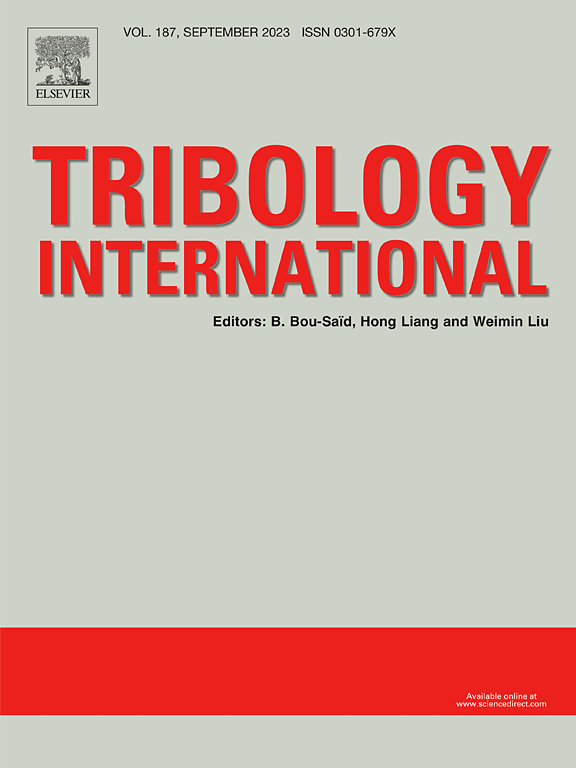通过混合激光淬火/USRP剪裁纳米位错网络的异常梯度:钢耐磨性的突破
IF 6.1
1区 工程技术
Q1 ENGINEERING, MECHANICAL
引用次数: 0
摘要
石油旋塞阀的动态密封界面在极端条件下会发生严重的磨损失效,因此需要替代传统的渗碳工艺。传统渗碳工艺受界面脆性、多步骤污染和低自动化程度的限制。提出了一种激光淬火和超声表面轧制相结合的复合工艺,在AISI 4140钢表面制备多尺度强化层。该层呈现出独特的“异常晶粒梯度-纳米位错结构”,并伴有碳过饱和。当LQ产生深度达800 μm的硬化层时,热边界效应导致表面晶粒异常粗化(表面马氏体为2.74 μm,地下马氏体为1.58 μm)。USRP通过高频动态应变有效地抵消了这一点,在粗马氏体中植入了高密度的纳米位错网络。这导致了超过10 GPa的特殊纳米硬度,挑战了经典的“粗粒软化”范式。由于三种协同机制,磨损量减少了74.4 %:超高强度屏障(结合纳米位错细胞钉住和碳过饱和马氏体),将塑性变形限制在亚微米深度,从源头抑制材料损失;硬梯度支撑的氧化摩擦层减少摩擦,防止直接金属接触;并形成了位错细胞催化马氏体纳米化和应力诱导ω相变的自适应磨损响应,建立了“损伤→纳米化/相变→硬化”的自强化循环。这些机制通过“预先设计的梯度-硬基质支持的氧化物形成-动态自适应响应”框架实现了深刻的耦合。这项工作推进了对多场耦合下非平衡结构演化的理论理解,同时为石油阀门和关键工程部件提供了一种适应性、变革性和环境可持续的表面强化解决方案。本文章由计算机程序翻译,如有差异,请以英文原文为准。
Tailoring an abnormal gradient with nano-dislocation networks via hybrid laser-quenching/USRP: A breakthrough in wear resistance of steel
Dynamic sealing interfaces of petroleum plug valves suffer severe wear-induced failure under extreme conditions, necessitating alternatives to traditional carburization—a process limited by interfacial brittleness, multi-step pollution, and low automation. This study proposes a hybrid process combining Laser Quenching (LQ) and Ultrasonic Surface Rolling Process (USRP) to fabricate a multiscale-strengthened layer on AISI 4140 steel. The layer exhibits a unique "anomalous grain gradient–nano dislocation architecture" accompanied by carbon supersaturation. While LQ produces a hardened layer reaching 800 μm in depth, thermal boundary effects lead to anomalous grain coarsening at the surface (surface martensite: 2.74 μm vs. subsurface: 1.58 μm). USRP effectively counteracts this through high-frequency dynamic strain, implanting a high-density nano-dislocation network into coarse martensite. This results in an exceptional nanohardness exceeding 10 GPa, challenging the classical "coarse-grain softening" paradigm. The wear volume is reduced by 74.4 %, attributed to three synergistic mechanisms: an ultra-high strength barrier (combining nano-dislocation cell pinning and carbon-supersaturated martensite) that confines plastic deformation to sub-micron depths, suppressing material loss at its source; a hard gradient-supported tribo-oxide layer reducing friction and preventing direct metallic contact; and a wear-adaptive response involving dislocation-cell-catalyzed martensite nanonization and stress-induced ω phase transformation, establishing a self-reinforcing cycle of "damage→nanonization/phase transformation→hardening". These mechanisms achieve profound coupling through a "pre-engineered gradient–hard substrate-supported oxide formation–dynamic adaptive response" framework. This work advances theoretical understanding of non-equilibrium structural evolution under multi-field coupling while delivering an adaptive, transformative, and environmentally sustainable surface strengthening solution for petroleum valves and critical engineering components.
求助全文
通过发布文献求助,成功后即可免费获取论文全文。
去求助
来源期刊

Tribology International
工程技术-工程:机械
CiteScore
10.10
自引率
16.10%
发文量
627
审稿时长
35 days
期刊介绍:
Tribology is the science of rubbing surfaces and contributes to every facet of our everyday life, from live cell friction to engine lubrication and seismology. As such tribology is truly multidisciplinary and this extraordinary breadth of scientific interest is reflected in the scope of Tribology International.
Tribology International seeks to publish original research papers of the highest scientific quality to provide an archival resource for scientists from all backgrounds. Written contributions are invited reporting experimental and modelling studies both in established areas of tribology and emerging fields. Scientific topics include the physics or chemistry of tribo-surfaces, bio-tribology, surface engineering and materials, contact mechanics, nano-tribology, lubricants and hydrodynamic lubrication.
 求助内容:
求助内容: 应助结果提醒方式:
应助结果提醒方式:


